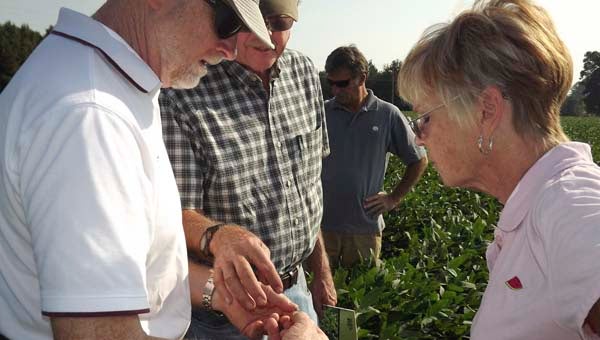Test crops line up for inspection
Published 12:04 pm Wednesday, September 18, 2013

Dr. Ames Herbert, left, shows a brown stink bug he found among the soybeans during last week’s inspection. — STEPHEN H. COWLES | TIDEWATER NEWS
STEPHEN H. COWLES/STAFF WRITER
stephen.cowles@tideawaternews.com
COURTLAND—Area farmers, extension agents, research scientists and seed company representatives last Wednesday took a close look at four crops: corn, soybeans, sorghum and cotton.
These on-site inspections were done at test plots established this past spring by the Southampton County Extension Service. The visitors examined the progress of different seed varieties as a way to determine which ones could offer the greatest yield.
Chris Drake, extension agent, requests seeds from companies they think are the best for this area, and all get a fair way to show what the varieties can do for farmers.
The first stop was a corn hybrid plot at Foxhill Farms. The eight agribusinesses represented here are Augusta, Coastal Agrobusiness, Dekalb, Dow, Dyna-Gro, Hubner, Pioneer and Syngenta. Planted among them was a DK 64-69 check variety as a way of comparing quality.
Looking through the varieties was Marcus Williams, an extension agent for Suffolk. He said he came to gauge how the city’s farmers are doing compared to those in Southampton, and get ideas for next year.
Though he’s only been farming for a couple of years, Richard Kitchen of Sebrell said these tours are useful.
“You get to talk to different people in the industry. What’s most helpful is when you can see crops side by side, and it’s really neat to see how they’re playing out,” he said.
Kitchen already uses Dekalb and Pioneer on his farm where he grows “a little bit of everything.”
Soybeans at the Newsoms farm of Edward Drake were next on the tour.
Chris Drake mentioned he’s never had to use an insecticide with the tested varieties, such as Hornbeck, Progeny and Southern States.
“Now is an excellent time to look at soybeans,” said Dr. Ames Herbert Jr., entomologist at the Tidewater Agricultural Research and Extension Center in Suffolk. To make his point, both he and Dr. Hillary Mehl, plant pathologist, noted seeing some frogeye leaf spot. This can be a serious issue for soybeans, but Mehl said she didn’t have the evidence to say there’s a resistance to fungicide.
Nonetheless, Ames commended Drake for his diligence in an otherwise healthy looking field.
Jason Francis of Francis Farms in Boykins also grows soybeans as well as cotton.
“I like to see the different varieties and their performance in a year and close to our region,” he said.
Crossing into Hertford County, N.C., a test field of sorghum belonging to D&J Farms was viewed and discussed. The crop can be used as a feed grain for hogs.
“Sorghum is one of the best things you can plant on cruddy land,” said Dennis Spruill of D&J Farms. He described it as land that’s “been beaned to death” or has a lot of clay. He also noted that deer won’t touch the crop until maturity.
After examining some of the plants, Dr. Maria Balota cautioned that head mold could occur at this point on. She’s TAREC’s assistant professor for plant pathology, physiology and weed science.
“Adequate nutrients are needed particularly with lots of rain,” she added.
Finally, Davis and Sons back in Courtland had a field of cotton for inspection.
“I expect very good yield data,” said Chris Drake, who added that he procured the seeds.
After having seen some nutrient stressed cotton already opening up, TAREC’s Dr. Hunter Frame said, “We’re hoping for a late fall. An early frost would affect yields.”
“We’ve had another outstanding year,” said Cameron Davis with PhytoGen. “There’s been lots of support in Virginia and that hasn’t gone unnoticed. There’s lots of new stuff coming, such as P495 next year, and some new nematode varieties.”
Davis added that Phytogen 339 has had limited use, but farmers could expect to see more in 2014.
“This is the first year using it, and it’s pretty darn good,” he said.
Zack Webb, a seed representative for DeltaPine, reminded everyone that yield is the first thing to think of when it comes to planting any crop.
“One of the biggest challenges is to get high yield and high fiber quality,” said Webb. “1311 impressed me, and I’m excited about 1321. It has great early-season vigor. In two years, three to five varieties will be launched.”





